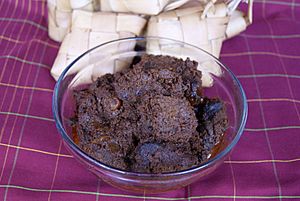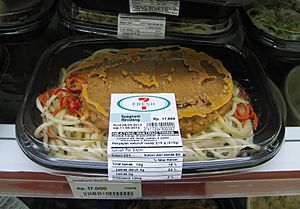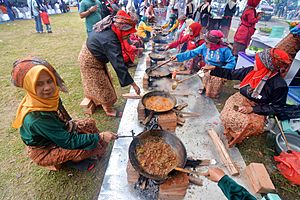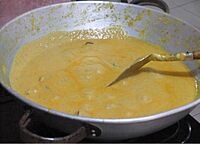Rendang facts for kids

Minangkabau randang from Padang
|
|
| Alternative names | samba randang, riyandang |
|---|---|
| Course | Main course |
| Place of origin | Attributed to multiple regions. See the perspectives here |
| Region or state | Southeast Asia |
| Serving temperature | Hot |
| Main ingredients | beef or chicken, chili pepper, turmeric, and coconut milk |
| Variations | rendang santan, rendang pedas, rendang kuning, rendang hitam, rendang tok, randang darek, randang pasisia |
| Similar dishes | basmah, kerutuk, kalio, beef fry, bafad |
Rendang is a special meat dish, a bit like a dry curry, that is famous in Southeast Asia. It is especially popular in Indonesia, Malaysia, and Singapore. It's made by slow-cooking meat, usually beef, in coconut milk and a mix of spices for many hours.
The long cooking process makes the meat incredibly tender and flavorful. It also helps preserve the dish so it can last for weeks without a refrigerator. Rendang is often served at big celebrations like weddings and festivals. It is so popular you can find it in many restaurants too. It is considered a national dish in Indonesia and a heritage food in Malaysia.
Contents
What Does "Rendang" Mean?
The word rendang comes from the Minangkabau word merandang. This word means to cook something slowly until the liquid is gone and the food becomes dry. So, "rendang" is not just the name of the dish. It is also the name of the special cooking method used to make it. In the past, the word could also mean "to fry."
The Story of Rendang
Where Did It Come From?
Rendang was first created by the Malay and Minangkabau people in Southeast Asia. The recipe was influenced by traders from India. They brought many of the spices used in rendang, like cardamom and coriander.
Later, Portuguese traders introduced chili peppers to the area in the 16th century. These new peppers became a key ingredient. They gave rendang its famous spicy kick.
A Perfect Food for Travelers
In the past, people from the Minangkabau culture often traveled far from home. They would travel for trade or to start new lives. Because rendang is cooked until it's very dry, it does not spoil easily.
This made it the perfect food to pack for long journeys. As people traveled, they brought rendang with them. They shared it with others and made it famous across the region.
Why is Rendang So Important?
Rendang is more than just food. It is a big part of the culture in Malaysia and for the Minangkabau people of Indonesia. It is traditionally served at important events like the Hari Raya festivals (Eid al-Fitr and Eid al-Adha) and weddings.
Making rendang is often a community activity. Family and friends gather to cook a large pot of it together for hours. This shows the importance of unity and working together.
The Philosophy of Rendang
For the Minangkabau people, the main ingredients in rendang have special meanings. They represent the four important parts of their society.
| Ingredient | Symbolism | Description |
|---|---|---|
| meat (dagiang) | niniak mamak (tribal leaders) | The leaders are seen as figures who bring prosperity and unite the community. |
| coconut milk (karambia) | cadiak pandai (intellectuals) | The intellectuals and teachers help solve problems and bring people together. |
| chili (lado) | alim ulama (religious scholars) | The religious scholars are firm in teaching and upholding religious values. |
| spice mixture (pemasak) | The Minangkabau community | Every person in the community has a role in preserving their culture. |
World Famous Flavor
Rendang is loved all over the world. In 2011, in a poll by CNN International, people voted it as the number one most delicious food in the world. Its amazing flavor has made it a star of Southeast Asian cooking.
How is Rendang Made?
Rendang is most often described as meat slow-cooked in coconut milk and spices. The preferred cut of beef for rendang is lean meat from the rear leg, which is perfect for slow cooking.
Key Ingredients
The most common rendang is made with beef. But the most important ingredients are coconut milk and a special spice paste called pemasak. This paste is a mix of ground-up spices like ginger, galangal, turmeric leaves, lemongrass, garlic, and chili peppers.
These spices not only add amazing flavor but also have antimicrobial properties. This means they help to preserve the meat naturally.
The Slow-Cooking Method
Making rendang takes a lot of time and patience. The meat is cooked slowly with the coconut milk and spices in a large pan. As it cooks, the liquid evaporates, and the coconut milk turns into oil.
The meat then starts to fry in this spicy oil. This makes it tender and coats it in a thick, dark, and delicious paste. This process can take many hours.
Different Kinds of Rendang
While beef rendang is the most famous, there are many different types. People make rendang with chicken, duck, mutton, and even vegetables or seafood. The recipes can also be different from place to place, creating unique flavors.
Wet and Dry Rendang
There are two main styles of rendang. The first is the classic dry rendang. It is cooked for a very long time until almost all the liquid is gone.
The second type is a wetter version called kalio. Kalio is cooked for a shorter time, so it still has a lot of creamy, spicy sauce. It's like a thick curry and is popular in the Netherlands.
Famous Regional Styles
In Malaysia, a famous version is rendang tok. It is a very dry and dark beef rendang that was once made for royalty in the state of Perak.
In West Sumatra, Indonesia, you can find randang darek (highland rendang). It is dark and smoky. There is also randang pasisia (coastal rendang), which often uses seafood and more spices.
Rendang in Modern Food

Rendang is so popular that its flavor is now used in all sorts of modern foods. You can find rendang-flavored burgers, spaghetti dishes, and even fillings for sandwiches.
There are also instant noodles with rendang flavor. These are a quick and easy way to enjoy its unique taste. Some restaurants have even created rendang-flavored sushi.
Images for kids
See also
 In Spanish: Rendang para niños
In Spanish: Rendang para niños














